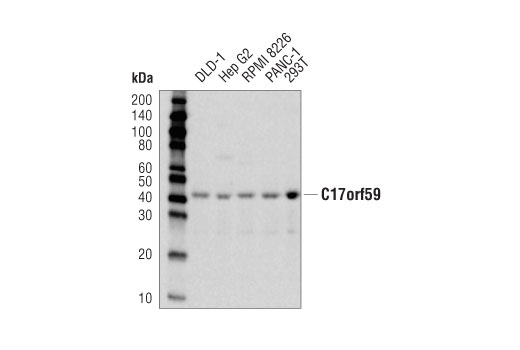WB
H Mk
Endogenous
42
Rabbit IgG
#Q96GS4
54785
Product Information
Product Usage Information
| Application | Dilution |
|---|---|
| Western Blotting | 1:1000 |
Storage
Specificity / Sensitivity
Species Reactivity:
Human, Monkey
Source / Purification
Monoclonal antibody is produced by immunizing animals with a synthetic peptide corresponding to residues surrounding Glu270 of human C17orf59 protein.
Background
mTORC1 kinase complex is a critical component to regulate cell growth in response to energy levels, growth factors, and amino acids (1-4). The GTPases RagA, RagB, RagC and RagD have been shown to interact with raptor in mTORC1 (3,4). A Ragulator complex, consisting of LAMTOR1/C11orf59, LAMTOR2/ROBLD3, LAMTOR3/MAPKSP1, LAMTOR4/C7orf59 and LAMTOR5/HBXIP, associates with the Rag GTPases and recruit them to the surface of lysosomes (5, 6). These interactions lead to mTORC1 activation in response to amino acid signals (3-6). In addition, C17orf59 was shown to interact with Ragulator and disrupt the interaction between Ragulator and Rag GTPases (7). This disruption prevents mTOR from localizing to the lysosomal membrane and therefore inhibits mTORC1 activation (7).
- Hay, N. and Sonenberg, N. (2004) Genes Dev 18, 1926-45.
- Wullschleger, S. et al. (2006) Cell 124, 471-84.
- Sancak, Y. et al. (2008) Science 320, 1496-501.
- Kim, E. et al. (2008) Nat Cell Biol 10, 935-45.
- Sancak, Y. et al. (2010) Cell 141, 290-303.
- Bar-Peled, L. et al. (2012) Cell 150, 1196-208.
- Schweitzer, L.D. et al. (2015) Cell Rep 12, 1445-55.
Species Reactivity
Species reactivity is determined by testing in at least one approved application (e.g., western blot).
Western Blot Buffer
IMPORTANT: For western blots, incubate membrane with diluted primary antibody in 5% w/v nonfat dry milk, 1X TBS, 0.1% Tween® 20 at 4°C with gentle shaking, overnight.
Applications Key
WB: Western Blotting
Cross-Reactivity Key
H: human M: mouse R: rat Hm: hamster Mk: monkey Vir: virus Mi: mink C: chicken Dm: D. melanogaster X: Xenopus Z: zebrafish B: bovine Dg: dog Pg: pig Sc: S. cerevisiae Ce: C. elegans Hr: horse GP: Guinea Pig Rab: rabbit All: all species expected
Trademarks and Patents
Limited Uses
Except as otherwise expressly agreed in a writing signed by a legally authorized representative of CST, the following terms apply to Products provided by CST, its affiliates or its distributors. Any Customer's terms and conditions that are in addition to, or different from, those contained herein, unless separately accepted in writing by a legally authorized representative of CST, are rejected and are of no force or effect.
Products are labeled with For Research Use Only or a similar labeling statement and have not been approved, cleared, or licensed by the FDA or other regulatory foreign or domestic entity, for any purpose. Customer shall not use any Product for any diagnostic or therapeutic purpose, or otherwise in any manner that conflicts with its labeling statement. Products sold or licensed by CST are provided for Customer as the end-user and solely for research and development uses. Any use of Product for diagnostic, prophylactic or therapeutic purposes, or any purchase of Product for resale (alone or as a component) or other commercial purpose, requires a separate license from CST. Customer shall (a) not sell, license, loan, donate or otherwise transfer or make available any Product to any third party, whether alone or in combination with other materials, or use the Products to manufacture any commercial products, (b) not copy, modify, reverse engineer, decompile, disassemble or otherwise attempt to discover the underlying structure or technology of the Products, or use the Products for the purpose of developing any products or services that would compete with CST products or services, (c) not alter or remove from the Products any trademarks, trade names, logos, patent or copyright notices or markings, (d) use the Products solely in accordance with CST Product Terms of Sale and any applicable documentation, and (e) comply with any license, terms of service or similar agreement with respect to any third party products or services used by Customer in connection with the Products.
